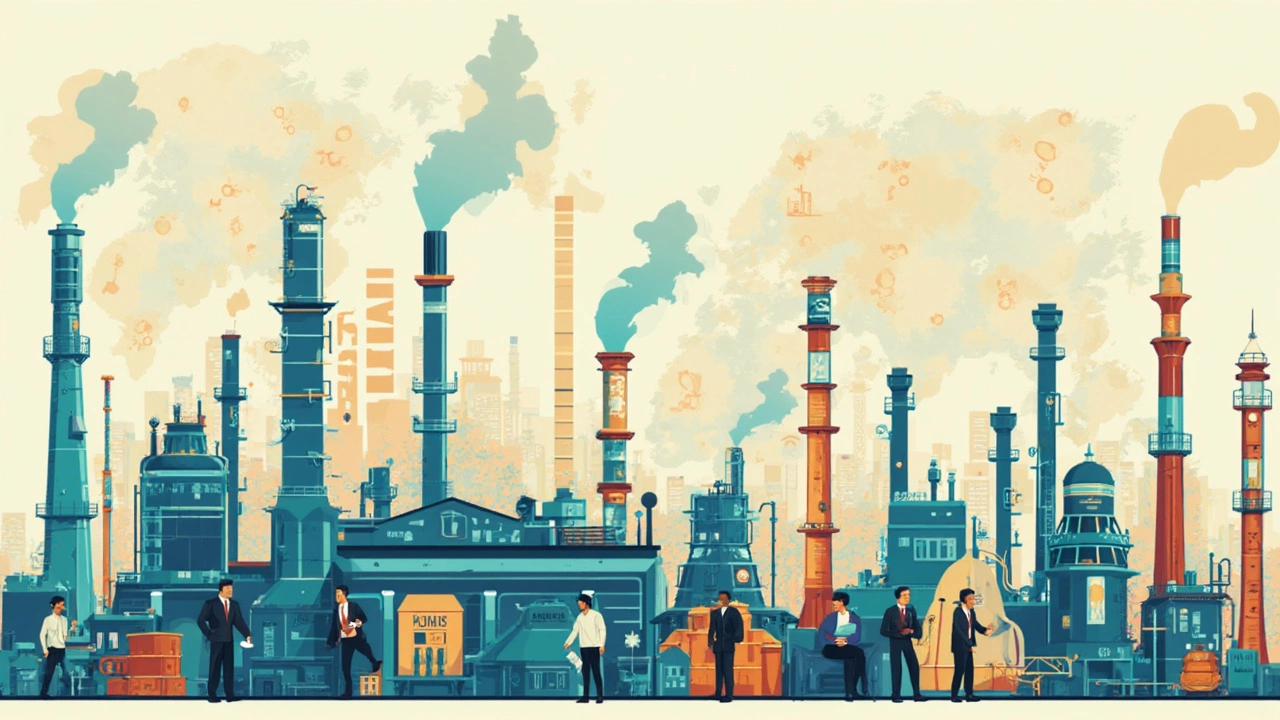Who actually holds the crown as the biggest chemical manufacturer on the planet? Here’s the short answer: BASF, a German company, keeps its grip on the top spot year after year. Their sales hit around $93 billion in 2023—that’s more than the GDP of a few small countries. But what really makes a chemical company “the largest”—sales, products, or global reach?
The answer is usually sales, plain and simple. BASF leads by that measure and by their network too—they have factories and labs in over 80 countries. But there’s something interesting happening: India’s chemical companies have been quietly climbing up the ranks. Reliance Industries and Tata Chemicals, for example, are now on the radar for global buyers and investors. Their rapid growth is closing the gap, step by step.
- What Makes a Chemical Manufacturer the 'Largest'?
- BASF—The Undisputed Global Giant
- Where Do Indian Chemical Companies Stand?
- How Does This Size Impact Buyers and Investors?
- Tips for Navigating the Global Chemical Industry
What Makes a Chemical Manufacturer the 'Largest'?
We hear the term “largest chemical manufacturer” all the time, but what does it really mean? In the industry, size isn’t just about how many chemicals a company produces—although that’s one factor. Usually, what really counts is total revenue or sales. The company with the highest sales numbers takes the bragging rights.
But there’s a little more to it than just money in the bank. Companies also get ranked by:
- Number of factories and production sites globally
- Diversity of chemical products—from simple industrial chemicals to fancy specialty ones
- Market share in different countries or regions
- Research spending and new patents
Let’s look at how this breaks down in real life. The biggest companies, like BASF, Dow, and Sinopec, have spread their factories across multiple continents. They’re making everything from paint ingredients to car additives to crop protection products. Global chemical market rules mean these manufacturers supply chemicals to every sector—automotive, agriculture, electronics, and even personal care.
Here’s a quick look at the numbers that matter most when ranking the largest chemical manufacturers:
| Ranking Factor | Why It Matters | Example |
|---|---|---|
| Total Revenue | Most trusted way to compare size | BASF annual sales: ~$93B (2023) |
| Number of Production Sites | Shows global reach and flexibility | Sinopec: 40+ plants worldwide |
| Diversity of Products | Makes them less vulnerable to market swings | Dow: plastics, coatings, specialty chemicals |
| R&D Spending | Keeps them ahead in innovation | BASF: €2.3B+ in R&D (2023) |
So the next time someone brings up the world’s largest chemical manufacturer, know that it’s not just about being big—it’s about having the sales, the reach, the variety, and the brains to stay on top.
BASF—The Undisputed Global Giant
BASF isn’t just another name in the largest chemical manufacturer race—it’s practically the measuring stick. Founded way back in 1865, the German company has built a presence in nearly every part of the world. As of 2023, BASF raked in global sales of about $93 billion. Their chemical portfolio is huge: plastics, agricultural products, coatings, performance materials, and even specialty ingredients for everything from car parts to vitamins.
BASF’s massive size isn’t just about sales. They operate over 230 production sites across more than 80 countries. Their main site in Ludwigshafen, Germany, is actually the world’s largest integrated chemical complex owned by a single company. Imagine a city-sized network of pipelines, factories, and R&D units all humming together—it’s that big.
They’re also a trendsetter in sustainability. BASF has invested heavily in reducing carbon emissions, recycling plastics, and green chemistry. In 2024, they reported a drop in CO₂ emissions per ton of product, thanks to renewable energy and smart manufacturing.
Here’s a quick data snapshot that’s handy for anyone comparing chemical giants:
| Indicator | BASF (2023) |
|---|---|
| Total Sales | $93 Billion |
| Countries Present | 80+ |
| No. of Employees | ~112,000 |
| Key Products | Plastics, Agrochemicals, Performance Materials |
If you’re buying, working with, or even investing in chemicals, knowing BASF’s scale tells you who sets prices, trends, and standards globally. For folks in India watching Reliance or Tata, it’s useful to see what’s possible at the very top, and what our homegrown companies are chasing.

Where Do Indian Chemical Companies Stand?
If you’re thinking the big global names always steal the show, you might be missing something important. Indian chemical companies aren’t just hanging around on the sidelines. Let’s get real: India is the sixth largest chemical producer in the world. And it’s growing way faster than the global average—roughly 10% every year.
So, who’s driving that growth? You’ll find these names leading the pack:
- Reliance Industries – Their chemicals business alone crossed $12 billion in sales last year. They’re not just into petrochemicals; they do everything from polymers to fertilizers.
- Tata Chemicals – These guys are big in soda ash, industrial chemicals, and specialty products. They’ve got plants in India and across the globe, including the UK and Kenya.
- UPL (United Phosphorus Limited) – The world’s fifth-largest agrochemical company. Their reach covers 138+ countries—pretty impressive.
- SRF Limited – Known for industrial chemicals and specialty chemicals, SRF has a strong export game, especially in fluorochemicals.
- Aarti Industries and Atul Ltd – Both punch above their weight in dyes, polymers, and healthcare chemicals.
Here’s a quick look at Indian heavyweights next to the global giant, as per 2023 sales:
| Company | Country | 2023 Sales (USD Billion) |
|---|---|---|
| BASF | Germany | 93 |
| Reliance Industries | India | 12 |
| Tata Chemicals | India | 3 |
| UPL | India | 6 |
| SRF Limited | India | 2.4 |
No, India’s top firms aren’t as huge as BASF yet, but the gap is shrinking. The government’s PLI (Production Linked Incentive) schemes and focus on chemical manufacturer exports are making a real impact. India is even being called the “China Plus One” destination, as international buyers hedge bets away from China and toward Indian suppliers.
Want to play in the chemical market? It’s smart to keep your eyes on these Indian names. They’re not just catching up—they’re reshaping the global chemical industry landscape.
How Does This Size Impact Buyers and Investors?
If you buy raw materials or invest in the largest chemical manufacturer companies, size isn’t just bragging rights. Big players like BASF, Reliance Industries, and Tata Chemicals set the tone for prices, product quality, and even the speed of delivery. You’re more likely to get consistent supply, bulk discounts, and access to the latest technology—something smaller companies might struggle with.
For buyers, working with a massive company means you’re dealing with someone who has years of experience managing risk, supply chain hiccups, and compliance. If you’re sourcing specialty chemicals for an Indian factory, the biggest global names usually give you more predictable quality and faster troubleshooting. That said, smaller firms can sometimes be more flexible on terms and faster on custom orders.
From an investor angle, the world’s big chemical manufacturers tend to have steadier earnings and better global visibility. Take BASF again—they weathered pandemic slowdowns better than most, thanks to their huge portfolio. Indian companies like Reliance and UPL are rapidly expanding their product lines, giving investors exposure to hot markets like agrochemicals, polymers, and specialty chemicals.
| Company | 2023 Sales (USD Billion) | Presence |
|---|---|---|
| BASF | ~93 | Global (80+ countries) |
| Reliance Industries (Chemicals segment) | ~42 | Global, strong focus on India |
| UPL | ~7 | Over 130 countries |
On top of that, big manufacturers are leading the switch to sustainable chemicals and green tech. Buyers looking to meet stricter environmental rules will find global brands already working on these solutions. As climate regulations ramp up, this could be a game changer for both chemical manufacturers India and globally.
One quick tip for Indian buyers and investors: don’t ignore the supply chain policies of these big companies. They often set tough standards for partners, so understanding their certification and compliance needs is a major plus. It’ll save you headaches down the road—whether you’re pitching for a tender or making a stock pick.

Tips for Navigating the Global Chemical Industry
The chemical industry moves fast, and getting your bearings can save you a lot of money and time. Whether you’re looking to buy, invest, or make career moves, here’s how you can make smart decisions and not just follow the crowd.
- Know Your Suppliers: Check not just who the world's largest chemical manufacturer is, but also their safety record, supply reliability, and presence in your region. BASF and Reliance might top the charts, but local giants like SRF and Aarti Industries deliver faster in India.
- Watch Prices and Regulations: Global chemicals aren’t immune to price swings. Top names like BASF adjust costs based on oil prices, shipping, and local rules. Keep an eye on regulatory changes in India—like the BIS standards for chemicals—that could affect imports or product selection.
- Focus on Sustainability: Big buyers now want ‘green’ chemicals. BASF spends billions on R&D for sustainable products because demand is growing, especially in Europe and the US. Indian leaders like Tata Chemicals are also investing in greener processes.
- Network at Industry Events: Chemical expos like ChemExpo India or international events in Frankfurt offer real deals and introductions you won't find online. Attendees often get better prices and insider info about new products and suppliers.
- Track Industry Rankings and Stats: Knowing who’s on top today helps while choosing partners. Here’s a quick look at 2023 revenue figures:
| Company | Country | Revenue (USD Billion, 2023) |
|---|---|---|
| BASF | Germany | 93 |
| Sinopec | China | 78 |
| Reliance Industries (Chemicals) | India | 18 |
| Tata Chemicals | India | 4.7 |
Being aware of these numbers keeps your expectations—and strategy—in check. Sometimes deals come from lesser-known firms that are hungry to grow.
Lastly, always keep an eye on supply chain risks. Natural disasters, political changes, or shipping delays can hit hard in this sector. Having backup suppliers or flexible contracts can save your business from sudden shocks. Stay connected, stay informed, and you’ll make the most out of this ever-changing market.
